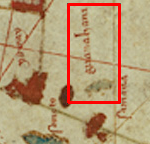Guanahani
Guanahani is an island in the Bahamas that was the first land in the New World sighted and visited by Christopher Columbus' first voyage, on October 12, 1492. It is not known precisely which island it was. Guanahani is the native Taíno name; Columbus called it San Salvador.
Upon his return to Spain in the spring of 1493, Columbus wrote a letter to Luis de Santangel, one of his patrons at the Spanish court. The letter was printed widely and translated into many languages, spreading the news of the discovery throughout Europe. In the letter, Columbus mentions Guanahani as the name of the first island he discovered, but provides no other details. Nevertheless, this single mention in a widely printed letter would have been enough to make the name Guanahani widely known at an early date.
Juan de la Cosa was owner and master of the Santa María, and as such sailed with Columbus on the first voyage. He was also a cartographer, and in 1500 de la Cosa drew a map of the world which is widely known as the earliest European map showing the New World. The Caribbean portion of the map shows Cuba and Hispaniola clearly, and a much more confused rendering of the Bahamas. Nevertheless, Guanahani is drawn in the Bahamas in a form that appears to show a group of islets rather than a single island, lying due north of the Windward Passage between Cuba and Haiti, in the central part of the Bahamas islands chain.
...
Wikipedia


